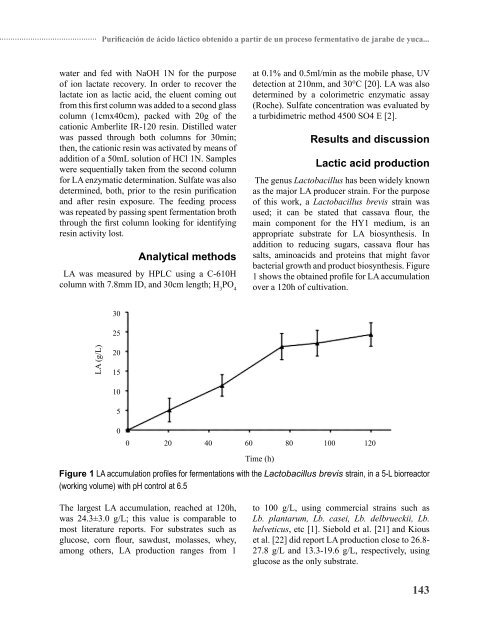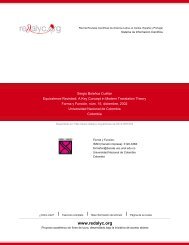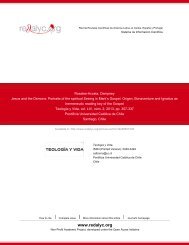fermentative process of cassava syrup using ion - Redalyc
fermentative process of cassava syrup using ion - Redalyc
fermentative process of cassava syrup using ion - Redalyc
You also want an ePaper? Increase the reach of your titles
YUMPU automatically turns print PDFs into web optimized ePapers that Google loves.
Purificación de ácido láctico obtenido a partir de un proceso fermentativo de jarabe de yuca...<br />
water and fed with NaOH 1N for the purpose<br />
<strong>of</strong> <strong>ion</strong> lactate recovery. In order to recover the<br />
lactate <strong>ion</strong> as lactic acid, the eluent coming out<br />
from this first column was added to a second glass<br />
column (1cmx40cm), packed with 20g <strong>of</strong> the<br />
cat<strong>ion</strong>ic Amberlite IR-120 resin. Distilled water<br />
was passed through both columns for 30min;<br />
then, the cat<strong>ion</strong>ic resin was activated by means <strong>of</strong><br />
addit<strong>ion</strong> <strong>of</strong> a 50mL solut<strong>ion</strong> <strong>of</strong> HCl 1N. Samples<br />
were sequentially taken from the second column<br />
for LA enzymatic determinat<strong>ion</strong>. Sulfate was also<br />
determined, both, prior to the resin purificat<strong>ion</strong><br />
and after resin exposure. The feeding <strong>process</strong><br />
was repeated by passing spent fermentat<strong>ion</strong> broth<br />
through the first column looking for identifying<br />
resin activity lost.<br />
Analytical methods<br />
LA was measured by HPLC <strong>using</strong> a C-610H<br />
column with 7.8mm ID, and 30cm length; H 3<br />
PO 4<br />
at 0.1% and 0.5ml/min as the mobile phase, UV<br />
detect<strong>ion</strong> at 210nm, and 30°C [20]. LA was also<br />
determined by a colorimetric enzymatic assay<br />
(Roche). Sulfate concentrat<strong>ion</strong> was evaluated by<br />
a turbidimetric method 4500 SO4 E [2].<br />
Results and discuss<strong>ion</strong><br />
Lactic acid product<strong>ion</strong><br />
The genus Lactobacillus has been widely known<br />
as the major LA producer strain. For the purpose<br />
<strong>of</strong> this work, a Lactobacillus brevis strain was<br />
used; it can be stated that <strong>cassava</strong> flour, the<br />
main component for the HY1 medium, is an<br />
appropriate substrate for LA biosynthesis. In<br />
addit<strong>ion</strong> to reducing sugars, <strong>cassava</strong> flour has<br />
salts, aminoacids and proteins that might favor<br />
bacterial growth and product biosynthesis. Figure<br />
1 shows the obtained pr<strong>of</strong>ile for LA accumulat<strong>ion</strong><br />
over a 120h <strong>of</strong> cultivat<strong>ion</strong>.<br />
Figure 1 LA accumulat<strong>ion</strong> pr<strong>of</strong>iles for fermentat<strong>ion</strong>s with the Lactobacillus brevis strain, in a 5-L biorreactor<br />
(working volume) with pH control at 6.5<br />
The largest LA accumulat<strong>ion</strong>, reached at 120h,<br />
was 24.3±3.0 g/L; this value is comparable to<br />
most literature reports. For substrates such as<br />
glucose, corn flour, sawdust, molasses, whey,<br />
among others, LA product<strong>ion</strong> ranges from 1<br />
to 100 g/L, <strong>using</strong> commercial strains such as<br />
Lb. plantarum, Lb. casei, Lb. delbrueckii, Lb.<br />
helveticus, etc [1]. Siebold et al. [21] and Kious<br />
et al. [22] did report LA product<strong>ion</strong> close to 26.8-<br />
27.8 g/L and 13.3-19.6 g/L, respectively, <strong>using</strong><br />
glucose as the only substrate.<br />
143
















